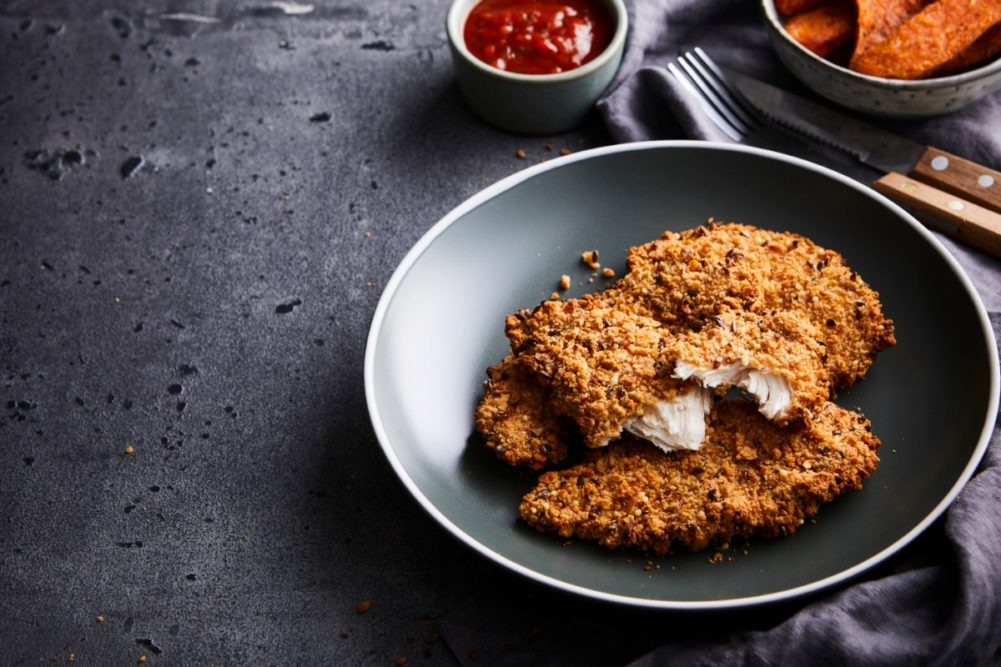Breadings have long been used by meat and poultry processors as a way to add value to lower cuts of protein and formed/emulsified products. Though many processors continue to apply breadings for these reasons, many also recognize that the ingredient system can serve as a vehicle for layering flavors and even boosting nutrition.
Culinary professionals appreciate how breadings may function as a canvas to introduce consumers to different flavors and textures by delivering the “new” through the “familiar” carrier. They are a way to provide an additional sensory dimension to meat and poultry products.
Breadings are dry coatings, particulates that stick to the surface of the protein. During cooking, which can be frying, baking or even stove top, the breading dries out instead of the protein it is covering, becoming crisp on the surface while helping the protein stay moist and tender. The finer the breading, the smoother the surface.
“There’s a lot of interest in making better breaded chicken, especially products intended for children. It’s a way of sneaking in extra nutrition,” said Ryan Kukuruzovic, corporate chef, Wixon Inc., St. Francis, Wis. “Pea protein with potato crumbs is a good example. The potato offsets the flavor of the pea protein and also provides a crispy crunch.”
He recommended the system be about 85% pea protein. For more adult-centric products, he suggests including seeds or nuts.
“Pumpkin seeds complement chicken very well,” Kukuruzovic said. “For a sweeter profile, maybe one with some Asian seasonings, include cashew crumbs.
“Heat is all the rage,” he said. “Consumers are curious about the many pepper profiles in the market but often hesitant to experiment on their own. Adding a designer pepper to breading is an easy way to differentiate in the marketplace.”

Jerry McDonald, vice president culinary, MiDAS Foods International, Oak Park, Mich., agreed that there’s a lot of innovation taking place in the spicy breaded chicken category. Pepper seasonings are an easy way to introduce consumers to regional and international recipes, he says.
“Regional Indian flavors are trending,” McDonald said. “They combine well with chickpea crumb breading, which is common in India. When it fries it gets ‘cracker crunchy’ crispy.
“Lupin bean breadings are popular in Australia,” he said. “Combine the flour with some flakes for an interesting texture. Lupin beans add protein and fiber to the meat.”
Breading systems based on legumes, starches and vegetables often exclude grains in order to make a gluten-free claim. Whatever the breading, prior to application, an ingredient system with adhesive properties is applied to keep the particulates in place. The system is usually determined by how the protein will be cooked. Flavors and seasonings can be included in any of the steps.
If baking is the process, then adhesion is usually accomplished with help from a liquid coating. This may be an egg wash, a starch or gum solution, or an emulsion such as yogurt, mayonnaise or buttermilk.
With batters and breadings intended for the fryer, the protein is often dusted with a flour-starch mixture before the covering is applied. The pre-dust absorbs surface moisture to create a barrier between the substrate and the fryer oil. This barrier reduces moisture loss from the substrate and prevents oil absorption within the substrate.
It’s advisable to add seasonings via the pre-dust for products intended for the fryer, as seasonings can wreak havoc on a fry oil. By adding them into the pre-dust, the protein still gets flavored while the breading layer keeps the particulates away from the oil.


